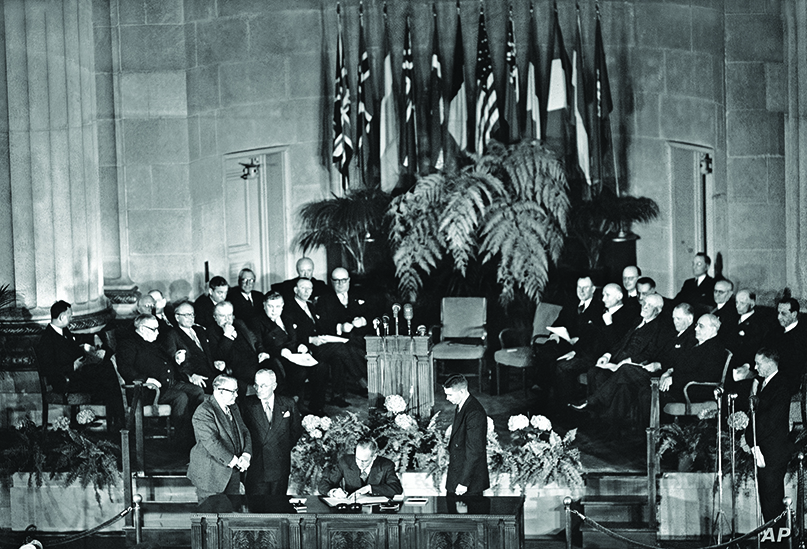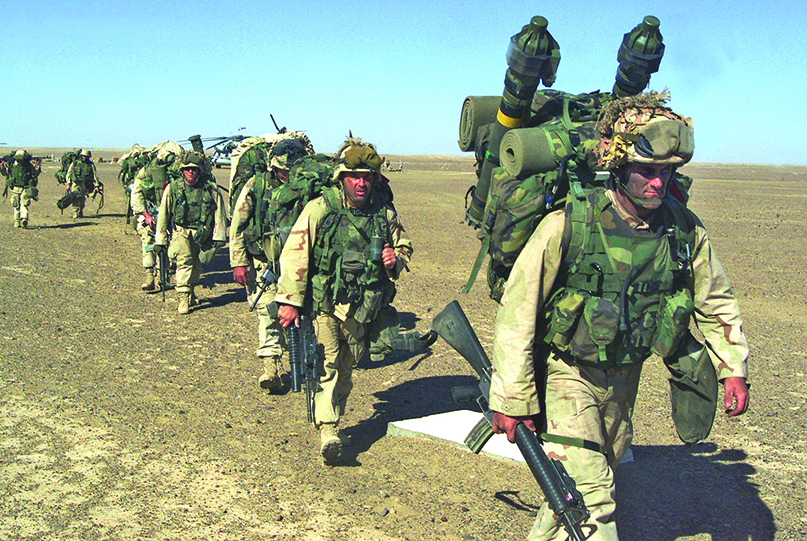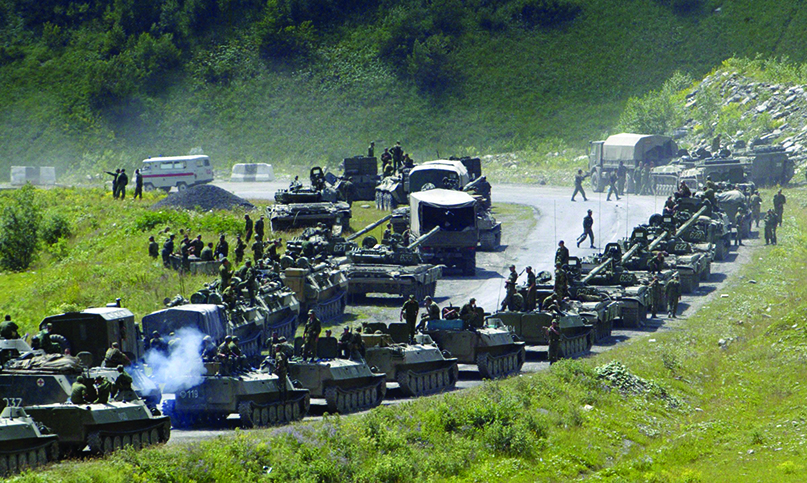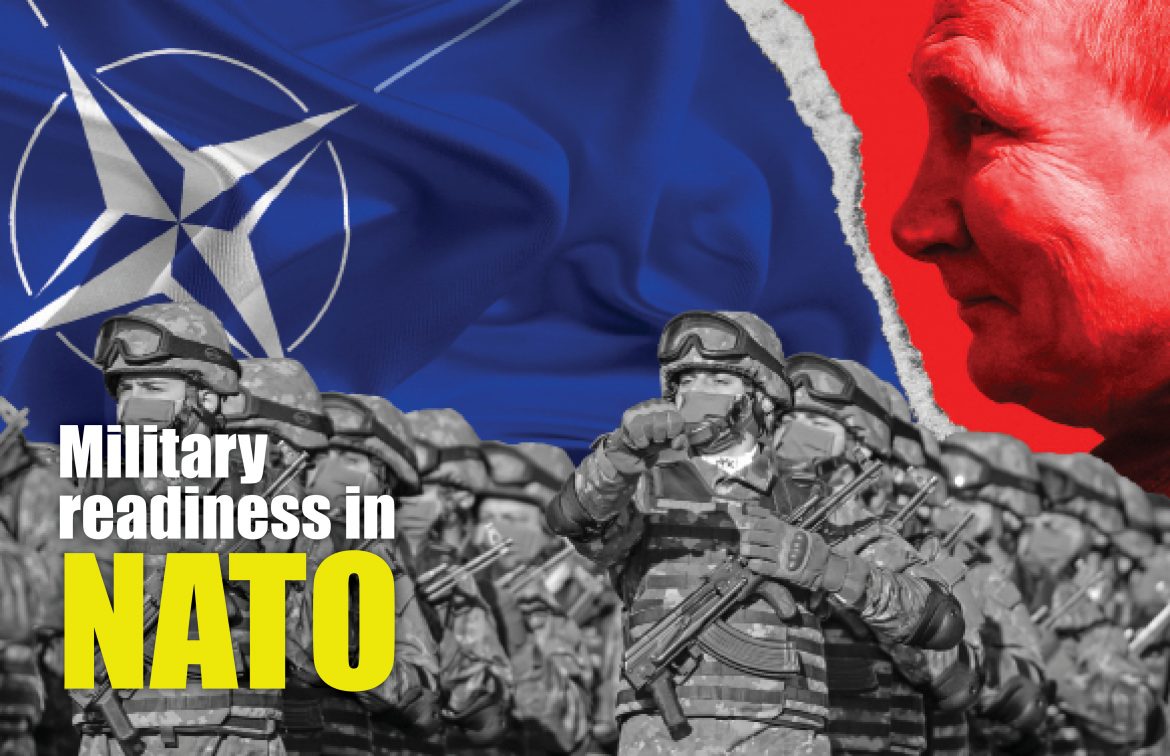The foundation and essence of NATO are to act as a collective security alliance to provide mutual and collective defense for member states via military and political means in case of any external threat to any member country of the alliance.
The North Atlantic Treaty Organization (NATO) is an intergovernmental military alliance formed based on the North Atlantic Treaty that was signed on April 4, 1949, as the member countries agreed to collectively defend each other in response to any external attack.
After the dissolution of the Soviet Union, the purpose of “NATO” became one of the most discussed topics on the international security agenda, as the original reason for its establishment was to prevent the Soviet Union from taking over the devastated continent of Europe in World War II.
Among the factors that contributed to laying the foundation of “NATO” were the long-term elimination of German militarism that ignited the two world wars and making sure the United States, which is considered a global security provider, fulfil its obligations to the alliance.
In other words, the goal was to keep the Germans down, the Americans in, and the Russians out.
All of these goals have been achieved and resulted in a completely different international security environment today, although there are three main issues that NATO must solve in the coming period, the first of which is the alliance’s return to the principle of collective defense, which is considered its primary function, secondly moving away from the United States’ tendency to use NATO as a vehicle for the liberal hegemonic strategy as well as the implementation of the idea of strategic independence into the NATO axis in addition to its fulfillment of the European Union’s defense commitments.
The show of force that Russia is currently conducting on Ukrainian lands and borders represents a clear challenge for NATO’s deterrence, as the alliance stands idly against the Russian occupation despite its commitments, which of course calls into question its effectiveness.

Secretary of State Dean Acheson signs the Atlantic defense treaty for the United States, April 4, 1949 in Washington. Vice President Alben W. Barkley, left, and President Harry Truman converse during the signing. (AP Photo)
The hegemony of American strategy through NATO
Being the only superpower in the international system after the Cold War, the U.S.A, in its search for a new grand strategy, formulated its concept of maintaining international safety and stability, within the framework of the spreading liberalism and democracy, and developed its own policies accordingly, it also considered NATO a tool for implementing these policies.
The application of the American foreign policy strategy to spread liberalism in Europe and Russia, especially during the two presidencies of Bill Clinton (1993-2001) and George W. Bush (2001-2009), began with a greater expansion to countries outside Europe, such as Afghanistan and Iraq, and NATO turned into one of the main tools in this strategic approach due to the high-level of US control over the alliance, as the EU was already trying to implement the liberal agenda in question.
As such, NATO’s strategic concepts have changed significantly after the Cold War era, incorporating crisis management and cooperative security into the principle of common defense.
However, expanding the concept of defense and security in this way has damaged the perception of the common threat and caused conflicts of interest among member countries.
Many member countries of the alliance refrained from participating in the new NATO missions, and the U.S unilateral initiatives attempted to compensate for that.
This situation has led to major problems among NATO members, especially apparent in the relations between Turkey and America on the Syrian issue.
NATO’s strategic independence
Above all, the success of defense alliances depends on the perception of the common threat, and so the main factor that must be taken into account here is the way the alliance perceives the entire international security environment, given the current situation and future perspective.
In this sense, a gap has emerged and widened between NATO’s original function and the role assigned to it since the end of the Cold War, leading to the emergence of unimportant commitments and narrowing the scope of its work, which caused the replacement of the importance of the principle of mutual defense by a liberal discourse that is damaging to the military aspect of the alliance, leaving it subject to superficial political discussions in the aforementioned process.
For its part, NATO defined the security environment very broadly in the process, decisively changing its previous perception of security, while at the same time launching a policy of expansion.
However, expanding the concept of security has rendered the primary function of the alliance ambiguous, while national differences have made achieving new and comprehensive goals difficult, thus, the different approaches of Member countries of NATO regarding the security environment neutralized the alliance’s role in countering terrorism and in operational objectives such as crisis management which have become ambiguous.

In this context, the conflict environments in Bosnia, Kosovo, Afghanistan, and Libya have become a cause of increased pressure on the alliance by serving as a constant testing ground for NATO, and the cost of providing elements such as credibility, reputation, defense, and deterrence has increased.
Similarly, the path of eastward expansion was founded on liberal assumptions that ignore military utility/cost analysis, with elements such as liberal and democratic values gradually replacing military missions.
It has been noted that countries such as Estonia, Lithuania, and Latvia, which were accepted into the alliance 10 years before Russia’s revisionist policies that emerged in 2014, had no complete conception of how they would be defended against any potential Russian threat in that period.
Only after Russia’s illegal annexation of Crimea did leading research centers such as RAND and IISS address the problem in question in their simulation studies.
Similarly, NATO’s statement that Ukraine and Georgia would become members of the alliance raised expectations in those countries and raised the perceived threat to Russia.
The refusal of membership to Ukraine and Georgia into NATO since 2008 due to Russian harassment, even if problems of democracy and corruption were raised, begs the question: what would have happened if there had been a Russian threat to the Baltic States in 2004, would they have been prevented from joining the alliance?
The likely answer to this question is: Yes. Leading us to the conclusion that the expansion of NATO isn’t fueled by the common perception of the Russian threat, but on the contrary, the presence of a threat prevents expansion.
Therefore, contrary to the predictions suggesting that the spread of liberalism and democracy would moderate foreign policy behavior, this security dilemma emerged due to the threat perception to Russia, as well as the emergence of defense weaknesses due to NATO expansion. The cost of this neglect became apparent for the first time in 2008 in Abkhazia and South Ossetia, then in 2014 in Crimea, and currently continues as Russia recognized the independence of the separatist regions in Donetsk and Luhansk, and attacks Ukraine and its capital, Kyiv.
In the end, the possibility of NATO waging war on Russia, which clearly shows its will to fight, is not currently on the table, and the current situation points to the gap between NATO’s post-Cold War rhetoric and policies and its will to act, confirming the necessary need for NATO to return to its main function.

NATO promises and the status quo
The idea of the European strategic independence is rooted in the past as a result of suspicions that the United States will not fulfill its security commitments. This idea, which France especially insistently defends, describes Europe’s ability to act independently on many military matters, particularly defense planning and procurement, and the reality is that the economic potential, technological infrastructure, and manpower of the European Union, are enough to achieve strategic independence, balance, and deter Russia, given that the potential of Russia diminished greatly since the period of the Soviet Union, while Europe has progressed compared to its state after World War II.
However, history suggests the opposite. Although the European Union’s formation of the common defense and security policy could be considered a step within the scope of strategic independence, it was unable to take any action to intervene in conflict areas, and so NATO had to handle the responsibility of intervention, as such tasks like maintaining safety and preventing crises in the EU have been limited and often helped by NATO-led tasks.
On the other hand, the failure of French weapons platforms to replace American products despite aggressive sales campaigns resulted in American weapons maintaining their importance in the armies of member countries on the other hand, French aircraft such as the Rafale have been favored by some non-European countries that cannot buy US or Russian products mostly due to US sanctions or fear of them.
The loss of European strategic independence
The main obstacle in the road to the European Union’s attainment of strategic independence and deterring Russia from aggressive behavior is the failure to raise the amount of defense expenditures of member countries to a sufficient level.
Although there has been an increase in recent years due to US insistence, the countries of the Union currently spend about 1.5% of their GDP on defense. This has led to the low levels of military readiness of the armies of the member countries, and the inability to keep up with military technological studies. Therefore, the European Union was unable to reach the status of an influential and deterrent factor alone but rather continued to depend on the American leadership.
Given this, it is crucial for Eastern European and Baltic countries such as the Czech Republic, Hungary, Latvia, and Estonia to be accepted into the European Union after their membership in NATO.
The puzzling and crucial question which cannot be answered then is: Would Russia have intervened militarily in Georgia and Ukraine if NATO had not adopted an expansionist policy? Because even though Ukraine was promised NATO membership in 2008, no one knows exactly why Russia waited until 2014 and then until 2022, however as mentioned before, the current reality now is showing a gap between NATO promises and the status quo, and hurting the alliance.
In conclusion, it can be said that, despite being the most successful defense organization in history, NATO’s survival as a military deterrent will be tied closely to solving these problems, which is almost impossible.
In addition, NATO’s return to a narrower definition of security revolving around the principle of common defense, the abandonment of America’s grand strategy of using NATO as a political tool, and Europe’s access to strategic independence, will help solve problems effectively.
Achieving these results does not mean tarnishing the existence of NATO as a defense organization. The new military areas of cooperation between member states and the possibility of deepening the current cooperation are high, and will probably result in advancements in combating cyber-attacks, increasing levels of preparedness for war, the establishment of joint defense projects interoperability, and improving social resilience through technological cooperation.
» By: Lieutenant-General chief of staff Dr. Amir Othman (security and strategic expert)













